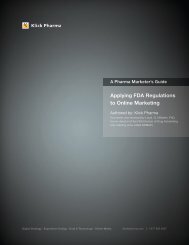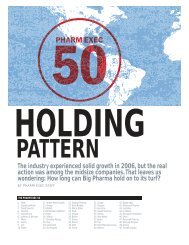When Girls Take the Lead - Pharmaceutical Executive
When Girls Take the Lead - Pharmaceutical Executive
When Girls Take the Lead - Pharmaceutical Executive
Create successful ePaper yourself
Turn your PDF publications into a flip-book with our unique Google optimized e-Paper software.
SPONSORED SUPPLEMENT<br />
www.focusreports.net<br />
Brazil Report<br />
The Brazilian pharmaceutical industry is organised around three<br />
main categories of players: multinational companies, local<br />
companies that manufacture branded generics or “similares”<br />
and local companies that produce generics.<br />
only differentiation between <strong>the</strong>m is <strong>the</strong> price of <strong>the</strong>ir products,”<br />
notes Nilton Paletta, country manager of IMS Brazil. Paletta<br />
adds: “Nowadays, <strong>the</strong> larger companies, such as EMS and<br />
Medley, have very large portfolios and have <strong>the</strong>refore been able<br />
to meet our clients' needs. Smaller companies have not been able<br />
to compete, price wise, due to <strong>the</strong> discounts and commercial situation<br />
of <strong>the</strong> larger organizations. In Brazil, <strong>the</strong>re is no incentive<br />
to buy large amount of prescription drugs, due to <strong>the</strong> availability<br />
of cheap generics brands.”<br />
The Industry and Consolidation<br />
The Brazilian pharmaceutical industry is organized around three<br />
main categories of players: multinational corporations (MNCs),<br />
often innovators; local companies that manufacture “similares”<br />
or branded generics; and local companies that produce nonbranded<br />
generics. The country also has 11 state owned laboratories-most<br />
of which are obsolete, with old manufacturing facilities<br />
and small production capacity. Five of <strong>the</strong>se labs produce<br />
most of <strong>the</strong> government's drug supply; <strong>the</strong> two leading stateowned<br />
labs are FURP and Farmanguihos.<br />
In Brazil government purchases<br />
comprise a significant<br />
portion of overall pharmaceutical<br />
purchases. Anti-<br />
AIDS is a major area for<br />
government purchases; <strong>the</strong><br />
government has procured<br />
<strong>the</strong>se drugs for free distribution<br />
to <strong>the</strong> public, which has<br />
led to a decrease in <strong>the</strong> number<br />
of AIDS-related deaths<br />
over <strong>the</strong> last three years.<br />
O<strong>the</strong>r top <strong>the</strong>rapeutic areas<br />
for product sales include cardiovascular,<br />
CNS, analgesics,<br />
anti-diabetic, hypertension,<br />
and anti-cancer.<br />
Although operational conditions<br />
remain challenging,<br />
foreign direct investment is<br />
increasing. Brazil is thus<br />
becoming an attractive<br />
regional base for multina-<br />
Private <strong>Pharmaceutical</strong> Market in 2005<br />
ALTANA PHARMA<br />
LTDA<br />
2,6%<br />
GRUPO CASTRO<br />
MARQUES<br />
2,6%<br />
SCHERING DO BRASIL<br />
2,7%<br />
EUROFARMA<br />
2,8%<br />
SCHERING PLOUGH<br />
2,9%<br />
BOEHRINGER ING<br />
2,9%<br />
tionals, including, most recently, US manufacturer Bristol-Myers<br />
Squibb. MNC investments in Brazil are aimed at minimizing<br />
<strong>the</strong>ir exposure to smaller, less well-regulated markets in <strong>the</strong><br />
region, while also developing <strong>the</strong> country's potential as an export<br />
base. Meanwhile, Brazil's indigenous pharmaceutical industry is<br />
consolidating with <strong>the</strong> encouragement of <strong>the</strong> country's economic<br />
development agencies, and <strong>the</strong> nation's private sector is reportedly<br />
investing heavily in drug marketing and product development<br />
Never<strong>the</strong>less, risks remain for those investing in Brazil's pharma<br />
research sector. Although this sector is clearly a priority for foreign<br />
investment, <strong>the</strong> country's healthcare reform initiatives are<br />
focused not on innovation but on providing affordable medicines<br />
to low-income citizens through <strong>the</strong> use of government price controls<br />
on prescription drugs and some OTC products. Meanwhile,<br />
foreign firms continue to complain that <strong>the</strong> government is changing<br />
regulations too abruptly and too often.<br />
A Complex Regulatory System<br />
<strong>When</strong> describing <strong>the</strong> regulatory system in Brazil, many sum it up<br />
in one word: unpredictable. “Regulations change from one day to<br />
MEDLEY<br />
3,7%<br />
NOVARTIS<br />
4,8%<br />
PFIZER<br />
5,0%<br />
OTHER COMPANIES<br />
51,2%<br />
EMS SIGMA PHARMA<br />
5,1%<br />
ACHÉ<br />
6,9%<br />
SANOFI AVENTIS<br />
6,8%<br />
Source: IMS Health<br />
S8 FOCUS REPORTS OCTOBER 2007






